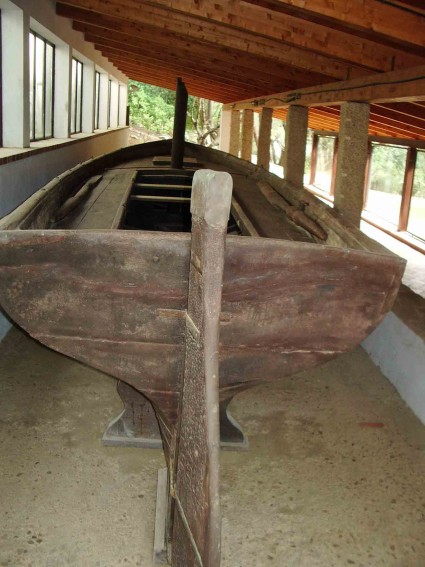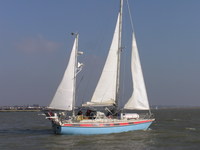
Roaring Girl
The adventures of the yacht Roaring Girl wandering the seas.
12 August 2013 | Ipswich, England
20 July 2012
20 July 2012
18 July 2012
17 July 2012
16 July 2012
10 July 2012
05 July 2012
04 July 2012
03 July 2012
03 July 2012
03 July 2012
02 July 2012 | Shanghai (high up!)
02 July 2012 | Shanghai (high up!)
02 July 2012 | Shanghai (high up!)
02 July 2012
02 July 2012 | Shanghai
01 July 2012
01 July 2012 | Moganshan Lu, Shanghai
The home of the Hero
11 July 2010

From the jetty a road leads inland. It's just a track, rather than a sealed surface. After about 15 minutes you come to a 'roundabout' with turnings left and right. We were fortunate enough to find a friendly shepherd, about to milk his bell-hung flock. He told us (and was able to make us understand) that we needed to turn left and follow the curving track. Once we'd done that, we saw a sign for the museo, which took us on a short scramble through the woods, and to the walled fence of the compound. Turn right and you quickly come to the entrance of the museum. Note (which we didn't find out till afterwards) that if you then go on another 50m you find a café, for coffee and croissants.
This compound is the last home of the hero of the Risorgimento, Guiseppi Garibaldi. He had been in exile, for participation in the republican uprisings inspired by Mazzini, spending much of the time in South America. When able to return, he bought the northern half of Caprera.
By early 1860, the moment had come for promoting an Italy of the Italians, creating a nation which had never existed before. At that time the northern third of the peninsula, including Piedmont and Nice, fell under the Duchy of Savoy, whose head held the title of King Vittorio Emmanuel of Sardinia (courtesy of mediaeval shenanigans by the Papacy). The southern third, the Kingdom of the Two Sicilies, an unhappy yoking of Naples and Sicily, was ruled by a junior branch of the Spanish Bourbons. In the convoluted events following the Napoleonic wars and France's protracted dithering about its preferred form of government, the House of Savoy agreed to cede Nice and Savoy itself for gains in the peninsula. This irritated Garibaldi, who was born in Nice, but in the end he yielded to such changes, and indeed to a monarchy rather than a republic, to pursue the dream of unity
Our hero raised a small force which obtained arms from the Savoy-Sardinian Prime Minister, Baron Cavour. Cavour also organised discreet naval protection for the garibaldini as they sailed south from Genoa, although publicly he denounced the action. Garibaldi's army rapidly conquered/liberated the land as far north as Naples.
At this point, Cavour became concerned that if the garibaldini invaded the lands held by the Rome, the major European powers would intervene to protect the millennium-old temporal power of the Pope. He therefore organised for the Piedmontese army to meet Garibaldi at Teano, in October, where Garibaldi ceded the territory he had won to the King.
In effect, Cavour's intervention stopped Garibaldi marching on Rome. He had handed the southern third of the country to the new regime and retired to his home on Caprera, where he ran an experimental farm for the remaining 27 years of his life. It is not clear whether he did so in a huff, or felt that he had done all he could; our sources differ on this point. Whatever his emotions, it seems that Garibaldi was essentially a charismatic mercenary captain whose passionate beliefs were well utilised by the wily rulers of Savoy to bring about a united Italy without provoking armed intervention by stronger powers.
From the shrine to Garibaldi that is his Casa Bianca, modelled on an American hacienda, you would think that he had single-handedly liberated all of Italy. The place is full of personal mementoes that further the cult - his sextants and swords, the bed he died in, his uniforms and gramophone. There is very little about the man himself. His later life is unchallenged: his first wife died in the Sicilian campaign, and for many years he lived with his partner Francesca, whom he finally married when he was 72. The small graveyard at the Casa Bianca includes Francesca, both their children (the last of whom died in 1959), plus at least two other daughters. One is described as being the child of one of the maids, the other's mother is not mentioned at all.
Notwithstanding this scepticism, there are many sweet touches. The 143 year old pine tree that Garibaldi planted at the birth of Clelia, Francesca's daughter. The tomb of his favourite mare, Marsala, and a lovely painting of his mother. For us, of course, there was a lot of interest in the two boats on display. One is a competition rowing scull. The other, shown in the picture, is the boat that the Sardinian Navy (as it then was) gave to Garibaldi in 1860, for navigating around the archipelgo. The stability of its keel, the strong construction but shallow draft are all typical and functional in these waters. They do not say what rig it carried, but it was probably the classical Latin vela of the area, a big sail suspended from a heavy yard which crossed the mast - now generally called the lateen rig.
The museum is EU5 each. You go round in small groups, led by an Italian guide, but they ticket office will give you an English leaflet if you ask. The Italians in our group were suitably reverential and we restrained any awkward questions for another time.
This compound is the last home of the hero of the Risorgimento, Guiseppi Garibaldi. He had been in exile, for participation in the republican uprisings inspired by Mazzini, spending much of the time in South America. When able to return, he bought the northern half of Caprera.
By early 1860, the moment had come for promoting an Italy of the Italians, creating a nation which had never existed before. At that time the northern third of the peninsula, including Piedmont and Nice, fell under the Duchy of Savoy, whose head held the title of King Vittorio Emmanuel of Sardinia (courtesy of mediaeval shenanigans by the Papacy). The southern third, the Kingdom of the Two Sicilies, an unhappy yoking of Naples and Sicily, was ruled by a junior branch of the Spanish Bourbons. In the convoluted events following the Napoleonic wars and France's protracted dithering about its preferred form of government, the House of Savoy agreed to cede Nice and Savoy itself for gains in the peninsula. This irritated Garibaldi, who was born in Nice, but in the end he yielded to such changes, and indeed to a monarchy rather than a republic, to pursue the dream of unity
Our hero raised a small force which obtained arms from the Savoy-Sardinian Prime Minister, Baron Cavour. Cavour also organised discreet naval protection for the garibaldini as they sailed south from Genoa, although publicly he denounced the action. Garibaldi's army rapidly conquered/liberated the land as far north as Naples.
At this point, Cavour became concerned that if the garibaldini invaded the lands held by the Rome, the major European powers would intervene to protect the millennium-old temporal power of the Pope. He therefore organised for the Piedmontese army to meet Garibaldi at Teano, in October, where Garibaldi ceded the territory he had won to the King.
In effect, Cavour's intervention stopped Garibaldi marching on Rome. He had handed the southern third of the country to the new regime and retired to his home on Caprera, where he ran an experimental farm for the remaining 27 years of his life. It is not clear whether he did so in a huff, or felt that he had done all he could; our sources differ on this point. Whatever his emotions, it seems that Garibaldi was essentially a charismatic mercenary captain whose passionate beliefs were well utilised by the wily rulers of Savoy to bring about a united Italy without provoking armed intervention by stronger powers.
From the shrine to Garibaldi that is his Casa Bianca, modelled on an American hacienda, you would think that he had single-handedly liberated all of Italy. The place is full of personal mementoes that further the cult - his sextants and swords, the bed he died in, his uniforms and gramophone. There is very little about the man himself. His later life is unchallenged: his first wife died in the Sicilian campaign, and for many years he lived with his partner Francesca, whom he finally married when he was 72. The small graveyard at the Casa Bianca includes Francesca, both their children (the last of whom died in 1959), plus at least two other daughters. One is described as being the child of one of the maids, the other's mother is not mentioned at all.
Notwithstanding this scepticism, there are many sweet touches. The 143 year old pine tree that Garibaldi planted at the birth of Clelia, Francesca's daughter. The tomb of his favourite mare, Marsala, and a lovely painting of his mother. For us, of course, there was a lot of interest in the two boats on display. One is a competition rowing scull. The other, shown in the picture, is the boat that the Sardinian Navy (as it then was) gave to Garibaldi in 1860, for navigating around the archipelgo. The stability of its keel, the strong construction but shallow draft are all typical and functional in these waters. They do not say what rig it carried, but it was probably the classical Latin vela of the area, a big sail suspended from a heavy yard which crossed the mast - now generally called the lateen rig.
The museum is EU5 each. You go round in small groups, led by an Italian guide, but they ticket office will give you an English leaflet if you ask. The Italians in our group were suitably reverential and we restrained any awkward questions for another time.
Comments
| Vessel Name: | Roaring Girl |
| Vessel Make/Model: | Maxi 120 |
| Hailing Port: | Ipswich |
| Crew: | Pip Harris and Sarah Tanburn |
| About: | Captain Sarah and Chief Engineer/Mate Pip moved on board in 2003 and finally made the break in 2006. Roaring Girl, launched in 1977, has already been round the world once, and has a lot more seamiles than the two of us put together. |
| Extra: | These pages aim to bring you our adventures as they happen, as well as Roaring Girl's sailing prowess. And to show off Pip's silverwork as well. |
Gallery not available
Who we are

Who: Pip Harris and Sarah Tanburn
Port: Ipswich

